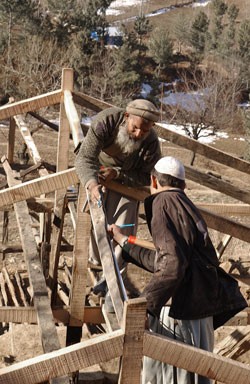
Challenge
In the fall, people living in Pakistan’s mountainous terrain at 5,000 feet above sea level usually start moving into the valleys to pass the winter, but the devastating earthquake in October 2005 disrupted this cycle. Subsistence farmers who store their wealth in wood supplies, food, animals, and fodder feared their entire net worth could be stolen if they left their assets unguarded. Women and children who lost their head of household feared that, given the lack of systematic land registration processes and loss of documents, if they did not occupy their land they risked losing their one remaining asset — land.
Initiative
In response, USAID provided 6,000 transitional shelters to help these people weather the harsh mountain winter. Communities participated in the decision-making process, considering issues such as how to prioritize who should be the first to receive shelters while minimizing potential conflicts as building was underway. In addition, USAID sponsored cash-for-work projects to help clear debris from shelter sites and recover materials suitable for reuse in construction. Builders learned new techniques for building sturdy structures and earned daily wages for constructing temporary houses. USAID provided tools and materials including plastic tarps, iron sheeting, wood stoves, and blankets to construct and supply each structure with basic survival items. Each shelter measures approximately 16 x 16 feet, protecting a household of eight to ten people. Cash-for-work initiatives also hired people to dig 400 latrines in select areas.
Results
USAID supported two community mobilizers and technical advisors to assist villagers as shelters were built and needs met. By the end of the 2005, USAID’s program distributed over 6,000 transitional housing kits, allowing approximately 35,000 people to move from emergency relief tents into a transitional shelter with at least one warm room they could call home.







Comment
Make a general inquiry or suggest an improvement.